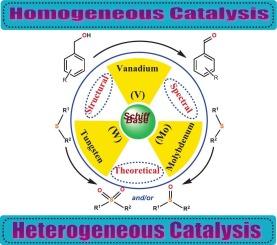钒、钼和钨希夫碱络合物对硫化物和醇的催化氧化:结构、光谱和理论的综合研究
IF 6.5
1区 化学
Q2 CHEMISTRY, PHYSICAL
引用次数: 0
摘要
本文综述了钒(V)、钼(VI)和钨(VI)希夫碱配合物催化氧化硫化物和醇的研究,包括结构、光谱和理论方面的见解。这项工作的新颖之处在于将单晶x射线衍射(SC-XRD),先进的光谱技术(FT-IR, NMR, UV-Vis)和密度泛函理论(DFT)相结合,建立了清晰的结构-性能-反应性关系。通过Mulliken电荷分布和前沿分子轨道(FMO)研究,系统分析了合成的腙基席夫碱配合物的电子结构、反应性趋势和催化机理。在硫化物氧化(产生亚砜或砜)和选择性苯甲醇氧化(产生醛)中评估了催化性能,其机理途径得到了计算模型的大力支持。此外,所选配合物在固体载体上的异质化表现出更高的可回收性和催化效率,突出了它们在可持续氧化过程中的潜在应用。本文章由计算机程序翻译,如有差异,请以英文原文为准。

Catalytic oxidation of sulfides and alcohols by vanadium, molybdenum, and tungsten Schiff base complexes: A combined structural, spectral, and theoretical study
This review article presents a comprehensive overview of our studies on the catalytic oxidation of sulfides and alcohols using vanadium(V), molybdenum(VI), and tungsten(VI) Schiff base complexes, integrating structural, spectral, and theoretical insights. The novelty of this work lies in combining single-crystal X-ray diffraction (SC-XRD), advanced spectroscopic techniques (FT-IR, NMR, UV–Vis), and density functional theory (DFT) to establish clear structure–property–reactivity relationships. The synthesized hydrazone-based Schiff base complexes are systematically analyzed to elucidate their electronic structures, reactivity trends, and catalytic mechanisms through Mulliken charge distribution and frontier molecular orbital (FMO) studies. Catalytic performance is evaluated in sulfide oxidation (yielding sulfoxides or sulfones) and selective benzyl alcohol oxidation (producing aldehydes), with mechanistic pathways strongly supported by computational modeling. Furthermore, the heterogenization of selected complexes on solid supports demonstrates enhanced recyclability and catalytic efficiency, highlighting their potential applications in sustainable oxidation processes.
求助全文
通过发布文献求助,成功后即可免费获取论文全文。
去求助
来源期刊

Journal of Catalysis
工程技术-工程:化工
CiteScore
12.30
自引率
5.50%
发文量
447
审稿时长
31 days
期刊介绍:
The Journal of Catalysis publishes scholarly articles on both heterogeneous and homogeneous catalysis, covering a wide range of chemical transformations. These include various types of catalysis, such as those mediated by photons, plasmons, and electrons. The focus of the studies is to understand the relationship between catalytic function and the underlying chemical properties of surfaces and metal complexes.
The articles in the journal offer innovative concepts and explore the synthesis and kinetics of inorganic solids and homogeneous complexes. Furthermore, they discuss spectroscopic techniques for characterizing catalysts, investigate the interaction of probes and reacting species with catalysts, and employ theoretical methods.
The research presented in the journal should have direct relevance to the field of catalytic processes, addressing either fundamental aspects or applications of catalysis.
 求助内容:
求助内容: 应助结果提醒方式:
应助结果提醒方式:


